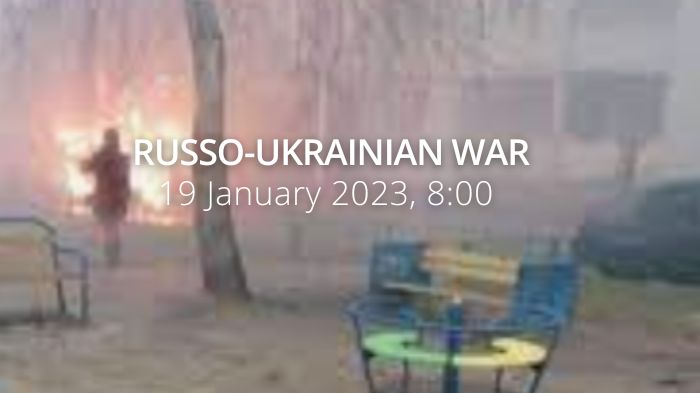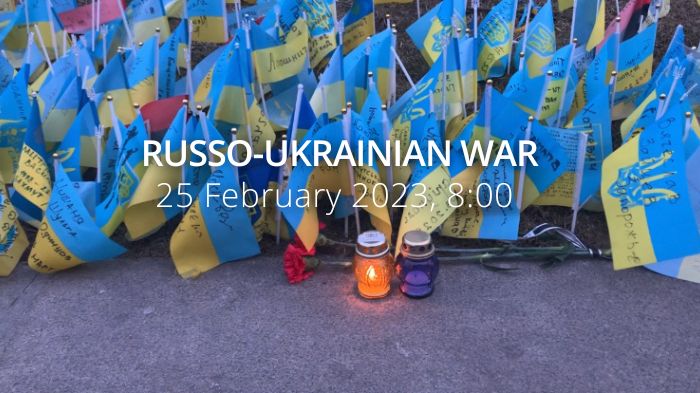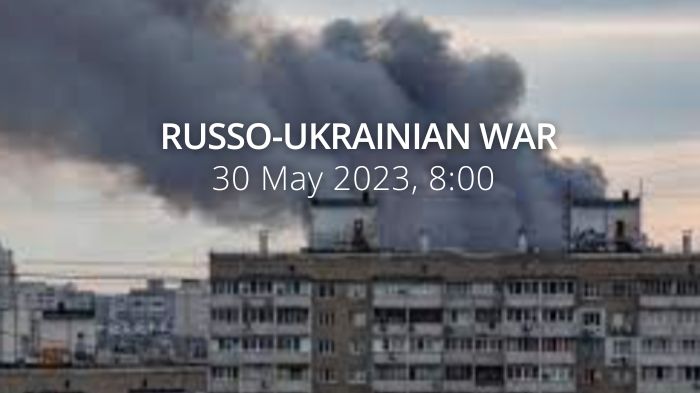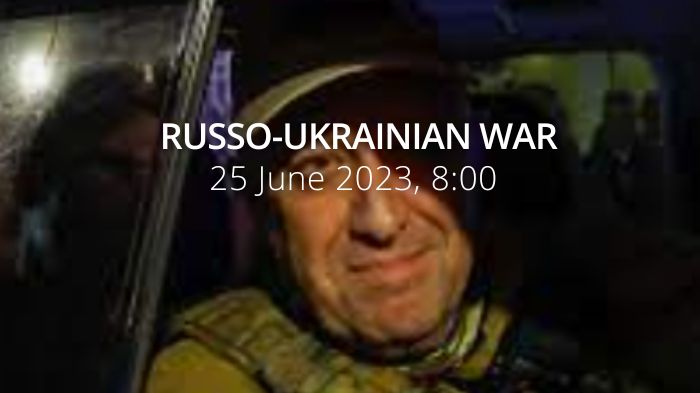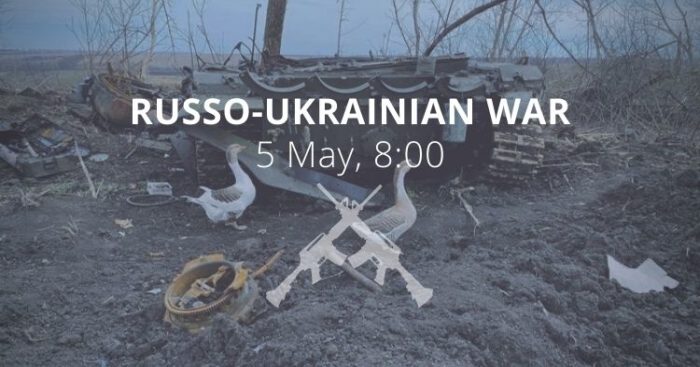A helicopter crashes near a kindergarten in Kyiv Oblast, 14 dead, including one child; 25 injured, including 11 children. The helicopter crash killed the top leadership of the Ukrainian Ministry of Internal Affairs: Denys Monastyrskyi, Minister of Internal Affairs, Yevhen Yenin, First Deputy Interior Minister, and Yurii Lubkovych, three of the Interior Minister's aides and security guards. Investigation ongoing.
UPD. According to the latest statement of Ukraine's Emergency Service, 14 people were killed in the helicopter crash in Brovary, including 1 kid.
Previous information about the death of 17 people (including 4 children) is not confirmed as of 3 pm, 18 January. pic.twitter.com/tU9B7x7npJ
— Euromaidan Press (@EuromaidanPress) January 18, 2023
Daily overview — Summary report, January 20, 2023
The General Staff’s operational update regarding the Russian invasion as of 18.00 pm, January 20, 2023 is in the dropdown menu below:
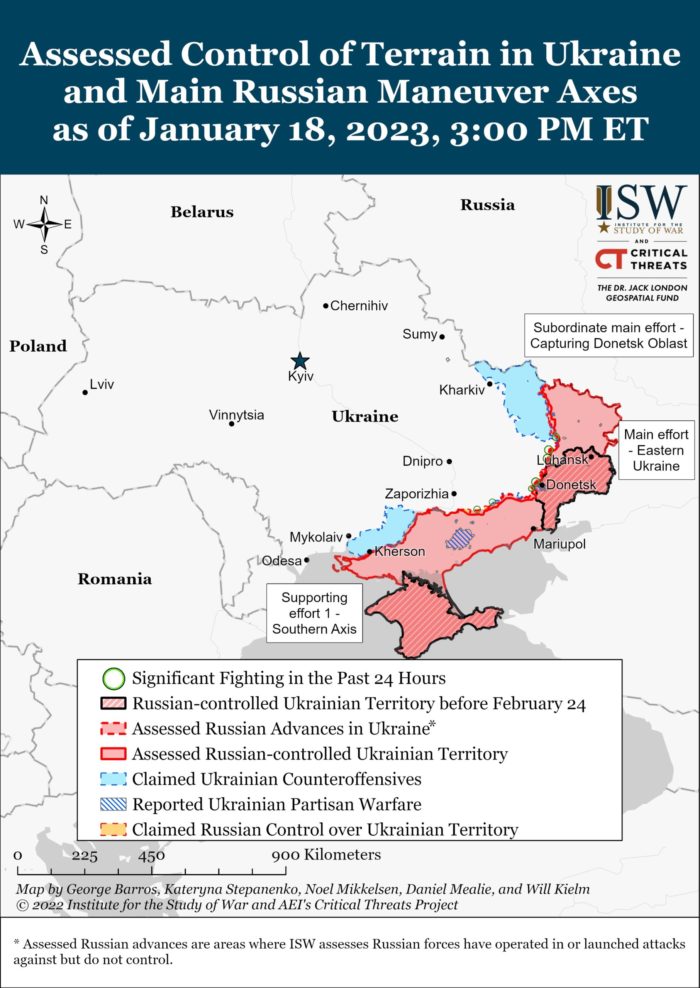
[Russian forces do not give up their intentions to capture the Donetsk Oblast within the administrative borders. The main efforts are concentrated on conducting an offensive along the Bakhmut axis. Conducts unsuccessful offensive actions on the Avdiiv axis. In addition, they are trying to improve the tactical position on the Lyman axis.]
[Zaporizhzhia axis: Russians carried out unsuccessful offensive actions in the areas of the settlements of Orihiv and Gulyaipole. Russian forces are defending the Kupiansk, Novopavlivsk and Kherson axes.]
Last day units of the Défense Forces of Ukraine repelled the attacks of the occupiers in the areas of the settlements of Bilogorivka in the Luhansk region and Terny, Verkhnyokamianske, Soledar, Sil, Krasna Gora, Bakhmut, Klishchiivka, Oleksandro-Shultyne, Kurdyumivka, Vodyane, Mariinka, Pobyeda and Paraskoviivka in the Donetsk region.
Russian forces carried out 25 airstrikes and launched more than 85 MLRS attacks. The threat of air and missile strikes by the Russian Federation on civilian objects remains high throughout Ukraine.
The situation remains stable in the Volyn, Polissya, Siversk and Slobozhansk directions. No offensive groups of Russian forces were detected in the areas bordering Ukraine. Certain units of the armed forces of the Russian Federation and the Republic of Belarus continue to perform tasks. In this way, Russian forces demonstrate their presence near the state border.
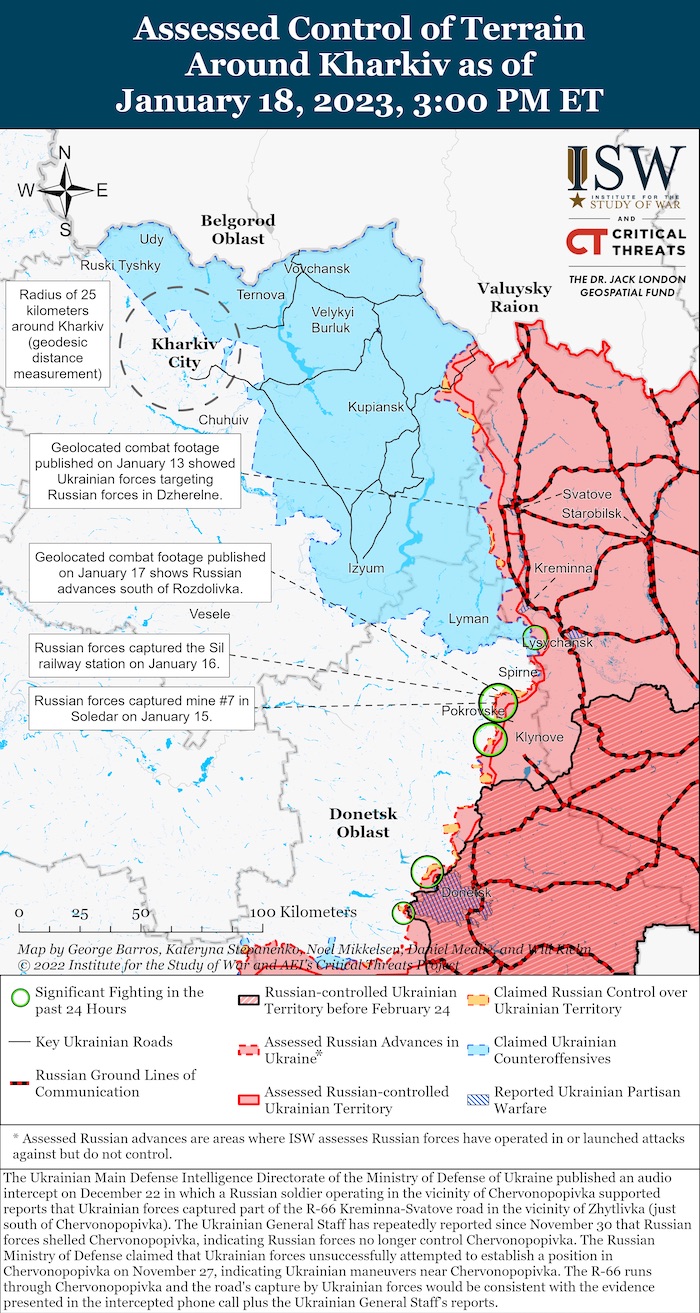
- In the Volyn, Polissya, Siversk and Slobozhansk directions, Russian forces carried out mortar and artillery shelling in the areas of settlements of Buchka, Chernihiv region; Popovka - Sumy; Budarky, Zemlianka, Gatishche, Zelene, Vovchansk, Ternova, Krasne, Kamianka, Chugunivka, Novomlynsk and Dvorichna of Kharkiv region.
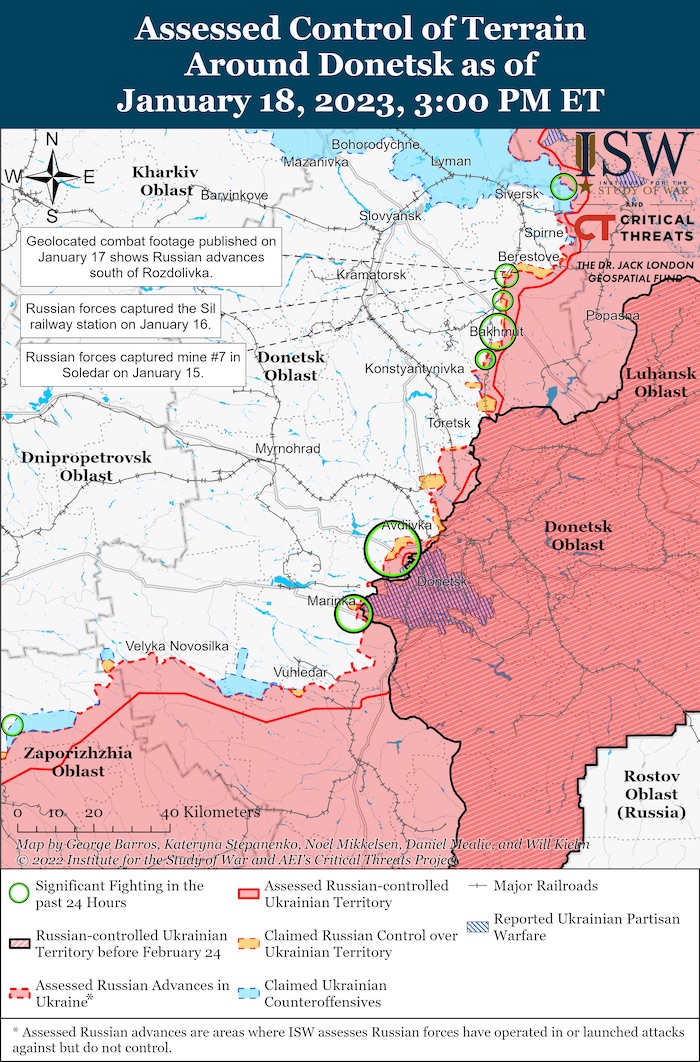
- In the Kupiansk direction, Russian forces shelled the districts of Kurylivka, Petropavlivka, Kislivka, Ivanivka, Krokhmalny, Synkivka, Berestovo, and Tabaivka in the Kharkiv region, as well as Stelmakhivka in the Luhansk region.
- In the Lyman direction, Russian forces fired at the positions of the Défense Forces near Druzhelyubivka in the Kharkiv region and Novoyehorivka, Nevsky, Chervonpopivka, and Dibrova in the Luhansk region.
- In the Bakhmut direction, areas of 22 settlements were hit by enemy artillery fire. Among them are Verkhnokamianske, Bilogorivka, Vesele, Mayorsk, Krasna Gora, Bakhmut, Klishchiivka, Kurdyumivka and Druzhba.
- In the Avdiivka direction, Avdiivka, Vodiane, Nevelske, Pervomaiske, Georgiivka, Mariinka and Novomykhailivka in the Donetsk region came under enemy fire.
- In the Novopavlivsk direction, Russian forces again shelled Velika Novosilka, Zolota Niva and Ugledar in the Donetsk region.
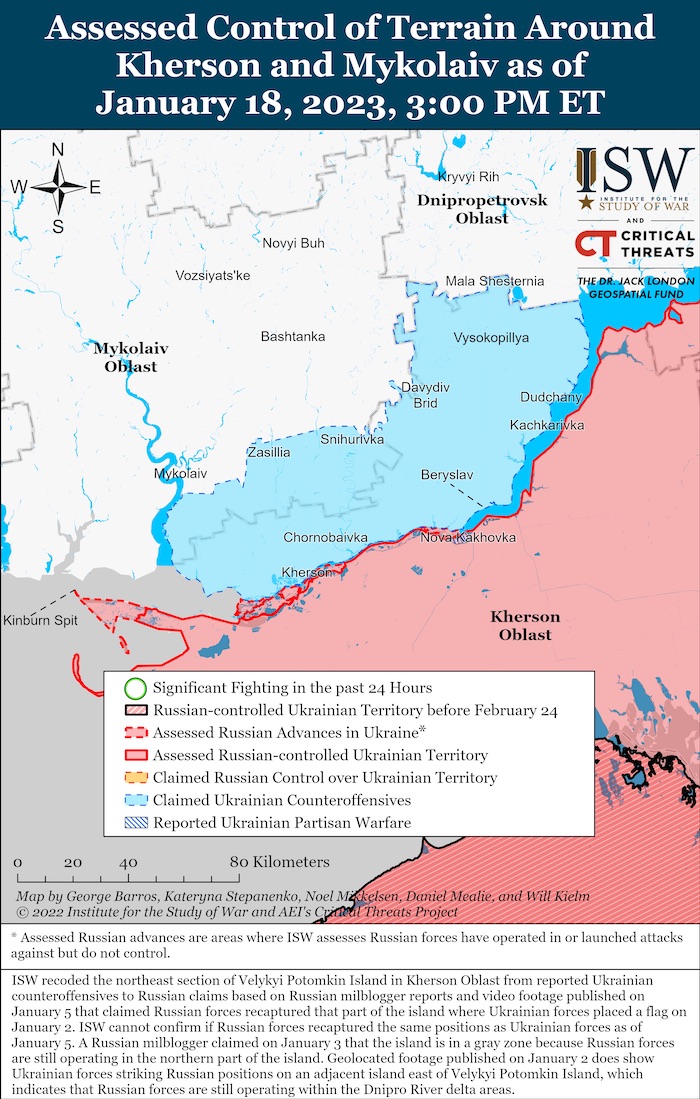
- In the Zaporizhzhia direction, 24 settlements were hit by artillery fire, in particular, Vremivka and Novopil in the Donetsk region and Poltavka, Malynivka, Gulyaipole, Shcherbaki, Stepove, Kamianske and Plavni in the Zaporizhzhia region.
- In the Kherson direction, the occupiers do not stop terrorizing the civilian population. In particular, the areas of more than 20 settlements were shelled by rocket launchers and barrel artillery. Among them are Antonivka, Berehove, Vesele, Kachkarivka, Yantarne and Kherson. Civilians suffered.
[Russian occupying forces do not stop looting the temporarily occupied territories. Thus, in the settlements of Gornostaivka, Kairy, Bratolyubivka, and Nyzhni Sirogozy of the Kherson Oblast, the occupiers, moving in groups of 10-15 people, search the empty houses of local residents and take away all household appliances and furniture.]
During the past day, Ukrainian Air Force made 13 strikes on enemy concentration areas and 3 strikes on the positions of the occupiers' anti-aircraft missile systems.
An enemy Ka-52 helicopter and Merlin-VR unmanned aerial vehicle were shot down.
Units of the missile troops and artillery of the Défense Forces of Ukraine hit 3 command posts, 5 areas of concentration of the occupiers' manpower, 1 ammunition depot and 2 other important enemy objects during the day.
Military Updates
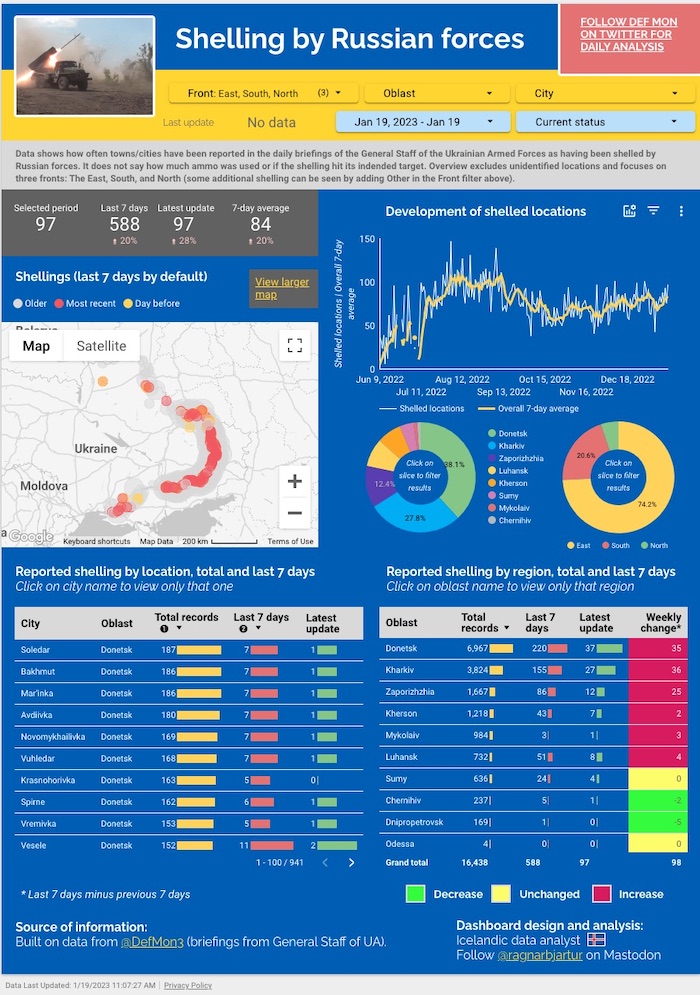
US intelligence denies Russia’s full control over Soledar and Bakhmut, Ukrinform reports, citing the National Security Council Coordinator for Strategic Communications in the White House, John Kirby. “The US intelligence claims that fierce battles are raging near the Donetsk region’s Soledar and Bakhmut. However, Russians do not have full control over any of these settlements. According to Kirby, as of this morning, the American side has not viewed two cities as captured by Russians unilaterally.
Kirby noted that Russians had made gradual progress in recent days, but this had cost them dearly. In fact, they are filling up the Ukrainian positions with their own corpses. Such efforts are led mainly by Prigozhin and his Wagner Group, with some support from the Russian military.
Kirby assumed that Prigozhin wants to be considered more relevant and indispensable on the battlefield than Russia’s traditional armed forces. Thus, tensions are persisting between Russia’s defence ministry and Prigozhin-led Wagner Group.”
According to British Defence Intelligence, (last 48 hours):
- Russia is likely considering deploying a small number of its new T-14 Armata main battle tanks in Ukraine. In late December 2022, imagery showed T-14s in a training area in southern Russia: the site has been associated with pre-deployment activity for the Ukraine operation.
- This followed pro-government Russian media outlets claiming T-14s were being prepared for deployment. However, it is unclear whether Russia has yet moved the type into Ukraine.
- Any T-14 deployment is likely to be a high-risk decision for Russia. Eleven years in development, the programme has been dogged with delays, reduction in planned fleet size, and reports of manufacturing problems. An additional challenge for Russia is adjusting its logistics chain to handle T-14 because it is larger and heavier than other Russian tanks.
- If Russia deploys T-14, it will likely primarily be for propaganda purposes. Production is probably only in the low tens, while commanders are unlikely to trust the vehicle in combat.
- By the end of 16 January 2023, Ukrainian forces had highly likely withdrawn from the Donbas town of Soledar, leaving Russian military and Wagner Group proxy forces in control. Ukrainian forces have likely established new defensive lines to the west.
- Russia’s advance on Soledar primarily consisted of Wagner forces and was a supporting operation aimed to enable the eventual envelopment of the larger settlement of Bakhmut. One of Ukraine’s two main supply routes into Bakhmut is now under increasing pressure.
- Imagery shows that since the start of January 2023, the south and east of Bakhmut have continued to be subjected to intense artillery bombardment. Ukrainian forces almost certainly continue to defend against Russian forces on the outskirts of the city.
Losses of the Russian army
As of Thursday 19 January, the approximate losses of weapons and military equipment of the Russian Armed Forces from the beginning of the invasion to the present day:
- Personnel – about 118530 (+760),
- Tanks – 3136 (+6),
- Armoured combat vehicles – 6235 (+10),
- Artillery systems – 2122 (+14),
- Multiple rocket launchers –MLRS - 442 (+0),
- Air defence means – 220 (+0),
- Aircraft - 287 (+0),
- Helicopters - 277 (+1),
- Automotive technology and fuel tanks – 4896 (+7),
- Vessels/boats - 17 (+0),
- UAV operational and tactical level – 1882 (+6),
- Special equipment – 190 (+0),
- Mobile SRBM system – 4 (+0),
- Cruise missiles – 749 (+0)
Russians shoot a soldier who deserted from the war in Ukraine, Ukrainska Pravda reports, citing the press service of the government of Lipetsk Oblast. “Russian news agencies have reported that Russian security forces shot soldier Dmitry Perov, who deserted from the war in Ukraine with his weapons. Russian Telegram channels reported that the soldier resisted as they tried to detain him.”
Wagner Group loses about two-thirds of its personnel in battles for Bakhmut and Soledar – expert, Ukrinform reports. "The two hottest spots remain: Bakhmut and Soledar. This is logical, let me remind you why: Putin tried to give the order to reach the administrative borders of the Donetsk region by the end of 2022. It did not work. In fact, they are suffering very unprecedented losses there and attempted to switch to Soledar, where Prigozhin tried to play himself as an independent commander.
He failed: Wagner Group suffered simply incredible losses there. At the moment, about 40,000 personnel are estimated to be killed and wounded, accounting for about two-thirds of this structure, military expert Petro Chernyk said. At the same time, he added that the mobilization and recruitment of prison inmates continue in Russia. Therefore, one should not underestimate the colossal number of people that Russian forces want to use in the war with Ukraine.”
Putin tells Russian workers they are making more missiles than the US, Ukrainska Pravda reports, citing RIA Novosti. “Russian President Vladimir Putin says that his country produces three times more air defence missiles than the United States.”
Humanitarian
Dnipro, Jan 14, 2023
Russia killed a beautiful young family1.5yo Makarchyk Huz, mother Nastia Ihnatenko, father Dmytro Huz perished when a Russian missile struck their ap't.
Fleeing Russian occupation & bombs, they moved to Dnipro from Tokmak, Zaporizhzhya Obl.
#RussiaKills pic.twitter.com/XbUQ43z3RQ— Euromaidan Press (@EuromaidanPress) January 18, 2023
Russia's latest attack damaged nine TPPs in Ukraine, Ukrinform reported on 17 January, citing Prime Minister Denys Shmyhal. "The latest massive attack had destructive effects on the Ukrainian energy sector. Generation facilities were damaged: one unit of a thermal power plant in the East and eight units of thermal power plants in the West of our country. Three main substations and one overhead line were damaged, the Prime Minister noted.
According to him, this led to an increased power deficit in the energy system, which, in turn, requires emergency power outages to be applied every day, starting from January 15. However, the power system withstood, and remained integral and manageable. Repair works are ongoing 24 hours a day. Every day, we work to ensure that Ukraine receives more power generators, transformers and other equipment to eliminate damage, Shmyhal said.”
Environmental
https://twitter.com/EuromaidanPress/status/1615656877873938433
Grossi tells about the creation of a safety zone around ZNPP, Ukrinform reports. “There is progress in establishing a safety zone around the Zaporizhzhia Nuclear Power Plant.
As for [safety] zone, I can tell you that we are making progress. We discussed this issue with the Prime Minister in Paris. We are also in contact with Minister of Foreign Affairs Dmytro Kuleba. In Kyiv, I will continue discussions today and tomorrow, IAEA Director General Rafael Mariano Grossi said at a joint briefing with Prime Minister of Ukraine Denys Shmyhal in Kyiv.
According to Grossi, there are several points on the safety zone: technical nuclear issues being discussed and other things regarding the location, the zone, its expansion that has to be discussed with the military and other specialists, which makes the process longer. I can say one thing: we are closer to a good result, the IAEA Director General said.”
IAEA Support and Assistance Mission launched at Chornobyl NPP, Ukrinform reports, citing International Atomic Energy Agency (IAEA) Director General, Rafael Mariano Grossi. “The International Atomic Energy Agency (IAEA) Support and Assistance Mission has been launched at Chornobyl Nuclear Power Plant (NPP).
IAEA continues to expand its presence in Ukraine. Today, I launched the IAEA Support and Assistance Mission in Chornobyl, Grossi wrote. In his words, IAEA experts will stay at all Ukrainian NPPs to provide vital nuclear safety and security assistance in these extremely difficult and challenging times.
A reminder that, according to the Ukrainian Energy Ministry, the presence of IAEA missions across all Ukrainian NPPs will enable the assessment of nuclear safety threats and enhance security at nuclear power facilities amid Russian continuous attacks.”
Legal
#Russia persecutes #CrimeanTatars, destroys their heritage because they expose the lies about its annexation of #Crimea #Ukraine #KhansPalace #UNESCO #StopRussia #StandWithUkraine https://t.co/wFL6CAnco6 pic.twitter.com/1QTkeJq7hU
— Halya Coynash (@halyapuff) January 18, 2023
Security Service of Ukraine considers several avenues of investigation into the helicopter crash in Brovary, Ukrainska Pravda reports, citing the SSU. “The Security Service of Ukraine (SSU) has started proceedings due to the crash of the helicopter in Brovary. Among the main avenues of investigation are the following: violation of flight rules, technical malfunction and intentional actions.”
Support
Defence Minister of Canada Anita Anand visits Kyiv today
Anand met with Ukraine's Defence Minister Oleksii Reznikov, and announced a donation of 200 additional armored vehicles, according to the release of Canada's National Defense. pic.twitter.com/bU1ofmShyc
— Euromaidan Press (@EuromaidanPress) January 18, 2023
Davos 2023: NATO chief calls for a significant boost in arms for Ukraine, Reuters reports. “Ukraine needs a significant increase" in weapons at a pivotal moment in Russia's invasion and such support is the only way to a negotiated peaceful solution, NATO Secretary-General Jens Stoltenberg said on Wednesday.
Defence leaders from around 50 countries and the North Atlantic Treaty Organization (NATO) will hold talks at Germany's Ramstein Air Base on Friday, the latest in a series of meetings since Russian forces swept into Ukraine nearly 11 months ago.
This is a pivotal moment in the war and the need for a significant increase in support for Ukraine, Stoltenberg told Reuters in an interview on the sidelines of the World Economic Forum in Davos, Switzerland. If we want a negotiated peaceful solution tomorrow we need to provide more weapons today."
Davos 2023: Ukraine's Zelenskyy says tank supplies should come quicker, Reuters reports. “Ukrainian President Volodymyr Zelenskyy told the World Economic Forum on Wednesday that Western supplies of tanks and air defence units should come more quickly and be delivered faster than Russia was able to carry out its own attacks.
The supplying of Ukraine with air defence systems must outpace Russia's next missile attacks, Zelenskyy said. The supplies of western tanks must outpace another invasion of Russian tanks."
Davos 2023-Polish President says crucial to give Ukraine modern weapons. Reuters reports. “Polish President Andrzej Duda said on Wednesday he was afraid that Russia was preparing a new offensive in Ukraine within months, adding that it was crucial to provide additional support to Kyiv with modern tanks and missiles.
They (Russia) are still very strong and we are afraid they are preparing for a new offensive in a few months so it's crucial to send additional support to Ukraine specifically modern tanks and modern missiles, Duda said at the World Economic Forum's annual meeting in Davos.”
White House may announce more aid to Ukraine ‘as soon as the end of this week’, Ukrinform reports. “The Biden administration says that additional Ukrainian aid could be announced as soon as the end of this week. The relevant statement was made by National Security Council Coordinator for Strategic Communications John Kirby in an interview with CNN.
Kirby didn’t answer when asked if the package would include tanks for the Ukrainians, saying he didn’t want to get ahead of things we haven’t announced yet. But, Kirby mentioned the US was focused on trying to make sure that we are giving Ukraine what they need in the fight that they're in.”
Pentagon looks to shift dynamic in Ukraine war, without Abrams tanks, Reuters reports. “The United States aims to break the dynamic of grinding warfare and near-frozen front lines in Ukraine with newly announced military capabilities that it hopes will breathe fresh momentum into Kyiv's battle against Russian forces, a senior Pentagon official said on Wednesday. But Colin Kahl, the Pentagon's top policy adviser, said the Pentagon still wasn't prepared to meet Kyiv's calls for gas-guzzling M1 Abrams main battle tanks.
I just don't think we're there yet, said Kahl, who had just returned from a trip to Ukraine. The Abrams tank is a very complicated piece of equipment. It's expensive. It's hard to train on. It has a jet engine. Kahl's remarks came ahead of this week's gathering of top defence officials from dozens of countries at the US Ramstein Air Base in Germany to coordinate military aid for Kyiv. […]
US officials, speaking on the condition of anonymity, said President Joe Biden's administration is next expected to approve Stryker armoured vehicles for Ukraine. […] The US provision of Bradley fighting vehicles, combined arms training, and other new weaponry for the Ukrainians is meant to enable Kyiv to change the dynamic of static defences by being able to fire and manoeuvre through the use of more mechanized forces, Kahl said.”
EU Parliament calls on Scholz to send Leopard tanks to Ukraine "without delay"
MEPs call for immediate deployment of modern weapons & next-generation air defence system, urging Scholz to deliver Leopard 2 main battle tanks to Ukraine without further delayhttps://t.co/NKN93HA9Xm pic.twitter.com/pY3EVOJ1Rw
— Euromaidan Press (@EuromaidanPress) January 18, 2023
All eyes on Germany when defence leaders meet on arming Ukraine, Reuters reports. “When dozens of defence ministers meet at an airbase in Germany on Friday, all eyes will be set on what Berlin is - and is not - willing to provide Ukraine. […] The focus is expected to be not on what the United States will provide, but on whether Germany will send its Leopard battle tanks to Ukraine or at least approve their transfer from third countries.
The US is expecting Europeans to take the lead, said Rachel Rizzo, a fellow at the Atlantic Council. I would expect the US to be rightly privately pushing the Europeans to dedicate more of their resources. […] US officials, speaking on the condition of anonymity, said President Joe Biden's administration is next expected to approve Stryker armoured vehicles for Kyiv but is not poised to send its own tanks, including the M1 Abrams.”
Berlin sets condition for US on exports of German tanks to Ukraine – source, Reuters reports. “Germany will send German-made tanks to Ukraine so long as the United States agrees to do likewise, a government source in Berlin told Reuters, as NATO partners remained out of step over how best to arm Ukraine in its war against Russia.
Ukraine has pleaded for modern Western weapons, especially heavy battle tanks, so it can regain momentum following some battlefield successes in the second half of 2022 against Russian forces that invaded last February.
Berlin has veto power over any decision to export its Leopard tanks, fielded by NATO-allied armies across Europe and seen by defence experts as the most suitable for Ukraine.”
MFA: Finland ready to participate in the transfer of tanks to Ukraine, Ukrinform reported on 17 January. "We in Finland have provided 12 military packages to Ukraine and we are talking about what else we can do as the European Union as a whole and as Scandinavian countries to help Ukraine today. I know that today there is a discussion about the transfer of tanks and other heavy weapons. We in Finland are ready to participate as much as we can," Minister for Foreign Affairs of Finland Pekka Haavisto said during the presentation of UKRAINE IS YOU project during the World Economic Forum in Davos.”
Canadian Defence Minister announces passage of 200 Senator APCs to Ukraine, Ukrainska Pravda reports, citing a statement of the Canadian government. "This new package of military assistance responds to a specific Ukrainian request for these vehicles, which are being purchased from Roshel [Canadian company based in Mississauga, Ontario – ed.]. This aid is valued at over $90 million and is allocated as part of the additional $500 million in military aid for Ukraine announced by Prime Minister Trudeau in November 2022, the statement said.
Senator APCs are equipped with state-of-the-art, best-in-class technology, and weapons can easily be mounted on them. These vehicles allow for the safe transport of personnel and equipment, and medical evacuations. […] The Senator APC has a steel body and glass capable of withstanding shots from a 50-calibre weapon. Senator also has an explosion-proof body, so it can withstand the detonation of a grenade or a mortar bomb. The car's tires have a Run Flat system with on-the-go inflation.
The vehicle is equipped with a system that can counteract chemical, biological, radiological attacks, generating clean air inside the sealed cabin.”
Latvia to transfer Stinger MANPADS, helicopters, drones and ammunition to Ukraine, Ukrainska Pravda reports, citing Delfi and European Pravda. “Ināra Mūrniece, Minister of Defence of Latvia, visited Ukraine this week as part of a working visit, where she met with Oleksii Reznikov, Ukraine’s Defence Minister, in Kyiv. […]
I confirmed the unwavering support of the government and the people of Latvia to Ukraine in this terrible war during my conversation with Ukraine’s Defence Minister. We will transfer new batches of military support to Ukraine in the near future, including Stinger MANPADS, helicopters, machine guns with ammunition and unmanned aerial vehicles. Latvia will continue the training of soldiers of the Ukraine’s Armed Forces of different levels this year; and it is planned to increase the intensity of training and train at least twice as many Ukrainians as we did in 2022, Mūrniece said after the meeting. […]
The Ministry of Defence reported at the beginning of January that the support that Latvia provides to Ukraine amounted to 0.93% of its GDP or more than 314 million euros. Approximately 300 million euros from this amount is military support provided by the Latvian government to Ukraine, and the rest is funds donated by Latvian people.”
International aid to Ukraine exceeds €113B, Ukrinform reported on 17 January. reports. “Since the beginning of the war, international partners have allocated more than EUR 113 billion to Ukraine, including military, financial, and humanitarian aid from foreign governments. Half of the allocated funds are financial aid, another third is security aid, and the rest is humanitarian assistance.
According to the data of the Ukraine Support Tracker system, which monitors the scale of international aid, 40 countries have become donors to Ukraine. The European Union has allocated almost EUR 52 billion, and US assistance has reached EUR 48 billion, the Ministry of Reintegration of the Temporarily Occupied Territories provided such data on its website, citing research by the Kiel Institute for the World Economy.
The list of donor countries also includes Great Britain, Canada, Australia, New Zealand, China, Japan, Norway, South Korea, Switzerland, Taiwan, Türkiye, and India. From them, Ukraine additionally received 13 billion euros in international aid.”
New Developments
- Russia's Lavrov compares West's approach to Russia with Hitler's 'Final Solution', Reuters Russian Foreign Minister Sergei Lavrov claimed that “Washington was using the same tactic as Napoleon and the Nazis in trying to subjugate Europe in order to destroy Russia. Using Ukraine as a proxy, he said, they are waging war against our country with the same task: the 'final solution' of the Russian question. Just as Hitler wanted a 'final solution' to the Jewish question, now, if you read Western politicians ... they clearly say Russia must suffer a strategic defeat."
- Jewish Congress demands that the Russian Foreign Minister apologises for comparing Russians to Holocaust victims, Ukrainska Pravda reports, citing The European Jewish Congress statement. “We are shocked and appalled by this shameful comparison drawn by Minister Lavrov between the actions of a coalition of democratic countries and Hitler’s persecution and murder of six million Jews in the Shoah. This is Holocaust distortion at its most basic level and we call on Mr. Lavrov to unequivocably apologise and withdraw these comments."
- We Must Help Ukraine Win the War, or We Will Be in Danger - Moldova's President, European Pravda “According to the Moldovan outlet NewsMaker, [Moldova's President Maia] Sandu has called on countries to help Ukraine win. Otherwise, she said, each of us will be in danger. We believe in democracy. We value democracy. We want to be part of the free world. The only solution is to unite. Yes, it is tough, but we must help Ukraine win this war. Otherwise, each of us will be in danger... We do not see Russia as a democratic state soon, which means that the danger remains, Sandu said.”
- Russian Foreign Minister on Zelenskyy's peace formula: "Out of the question", Ukrainska Pravda reports, citing TASS. "Zelenskyy puts forward some absolutely ridiculous initiatives, a 10-point plan, where he squeezed in all he could: food security, energy security, biological security, withdrawal of Russian troops from everywhere, repentance of the Russian Federation, a tribunal, condemnation and so on. Negotiations with Zelenskyy on his initiatives are out of the question."
- Ukraine’s Foreign Ministry to Russian counterpart: Moscow will have to comply with Zelenskyy’s "Peace Formula", Ukrainska Pravda reports, citing Oleh Nikolenko, spokesman for Ukraine’s Foreign Ministry. “Ukraine’s Foreign Ministry has responded to the Russian Foreign Minister Sergey Lavrov’s claim that negotiations on the terms of the "Peace Formula" proposed by Ukrainian President Volodymyr Zelenskyy are impossible. Ukraine’s Foreign Ministry believes that Lavrov’s statement bears out Russia’s unwillingness to engage in the peace process." Lavrov has once again articulated Russia’s real intentions. Moscow has no interest in peace at all.”
- UN Secretary-General believes Ukraine-Russia peace talks unlikely in near future, Ukrainska Pravda reports, citingthe UN Press Service. “UN Secretary-General António Guterres, speaking at the World Economic Forum in Davos on 18 January, has acknowledged that he does not consider peace talks between Ukraine and Russia likely to take place in the near future.”
- President: NATO is the best security guarantee for Ukraine, Ukrinform "As far as NATO is concerned, of course, we understand that security guarantee is one of our priorities. For example, if we talk about our Peace Formula, it’s one of the ten priorities. We understand that we are not in NATO yet. And, unfortunately, Russia also understands this and fights with it to prevent our path to NATO from being short. But I am aware that we are on this path. NATO is the best security guarantee for Ukraine, our society, and the future of our children. But, nevertheless, while we are on this path, we offered security guarantees for our state. We believe that the civilized world will support our proposals," the President of Ukraine said addressing the World Economic Forum in Davos via video link on Wednesday.”
- European Parliament called on Germany to hand over Leopard 2 tanks to Ukraine, Ukrainska Pravda “Members of the European Parliament have called on Chancellor Olaf Scholz of Germany to hand over the immediate deployment of modern weapons and an air defence system to Ukraine. This is stated in the 2022 annual report on the implementation of the Common Security and Defence Policy approved on Wednesday. Earlier on Wednesday, Charles Michel, the President of the European Council, said that he supported the idea of providing Ukraine with tanks and other necessary types of weapons. Ursula von der Leyen, the President of the European Commission, said that the partner countriesshould hand over Western battle tanks to Ukraine.”
- Helicopter crash at Brovary: rescue operations complete, Ukrainska Pravda reports, citing the State Emergency Service of Ukraine. " On the morning of 18 January, ahelicopter crashed near a kindergarten in Brovary in Kyiv Oblast, causing a fire. As of 15:45, the search and rescue operations are completed. 14 people were confirmed dead, including one child; 25 people were injured, including 11 children. The helicopter crash killed the top leadership of the Ukrainian Ministry of Internal Affairs: Denys Monastyrskyi, Minister of Internal Affairs, Yevhen Yenin, First Deputy Interior Minister, and Yurii Lubkovych, three of the Interior Minister's aides and security guards.”
- NATO deploys surveillance planes to Romania, to monitor Russian activity, Reuters “A NATO surveillance plane arrived in Romania on Tuesday to bolster the military alliance's eastern flank and help monitor Russian military activity. The plane, the first to be deployed, landed at an air base near Bucharest and two more are expected to land later in the day and on Wednesday. They are due to stay for several weeks.”
https://twitter.com/EuromaidanPress/status/1615813611514957848
Assessment
https://www.understandingwar.org/backgrounder/russian-offensive-campaign-assessment-january-18-2023*
- On the war.
The Institute for the Study of War has made the following assessment as of January 19, 2023:
Russian forces continued offensive operations around Soledar on January 18. A Russian milblogger claimed that Russian forces attempted to advance towards Verkhnokamianske (20km northeast of Soledar), Spirne (18km northeast of Soledar), and Krasnopolivka (3km north of Soledar). The Ukrainian General Staff reported that Ukrainian forces repelled a Russian assault near Sil (3km northwest of Soledar). […] The United Kingdom Ministry of Defense (UK MoD) reported that Ukrainian forces withdrew from Soledar by the end of January 16 and that they continue to defend against Russian forces on the outskirts of the settlement. Geolocated footage posted on January 18 indicates that Russian forces have likely advanced further west of Soledar in Dvorichchia (2km west of Soledar). The Ukrainian General Staff also reported that Ukrainian forces repelled a Russian assault near Krasna Hora (5km southwest of Soledar).
The Russian MoD continues to attempt to downplay the role of the Wagner Group in claimed tactical advances in the Soledar area. The Russian MoD’s use of "volunteers of assault detachments" to describe the formations that supposedly captured Sil likely refers to Wagner Group fighters. The Kremlin previously challenged Wagner Group financier Yevgeny Prigozhin’s claim that Wagner Group forces were solely responsible for capturing Soledar. The Russian MoD faced significant backlash when it failed initially to acknowledge the Wagner Group in its announcement of the capture of Soledar. The Russian MoD is likely using odd language to simultaneously shield itself from criticism that it is not acknowledging the Wagner Group while also downplaying the Wagner Group’s role in tactical advances in the Soledar area.
Russian forces continued offensive operations around Bakhmut on January 18. The Ukrainian General Staff reported that Ukrainian forces repelled Russian assaults near Bakhmut itself and Klishchiivka (7km southwest of Bakhmut). A Russian milblogger claimed that Wagner Group fighters attempted to advance to the western outskirts of Klishchiivka and are engaged in fierce battles with Ukrainian forces near the settlement. The Russian milblogger also claimed that Russian forces attempted to advance towards Pivnichne (22km southwest of Bakhmut).
Russian forces continued offensive operations in the Avdiivka-Donetsk City area on January 18. The Ukrainian General Staff reported that Ukrainian forces repelled Russian assaults within 32km southwest of Avdiivka near Vodyane, Nevelske, Marinka, and Pobieda. A Russian milblogger claimed that Russian forces unsuccessfully attempted to cut a road that runs through part of Ukrainian-controlled Marinka. […] Another Russian milblogger claimed that Russian forces conducted a ground attack near Kamianske (5km northeast of Avdiivka), where Ukrainian forces reportedly still control the H-20 highway. The Ukrainian General Staff reported that Russian forces continued routine indirect fire along the line of contact in Donetsk and eastern Zaporizhzhia oblasts.
Russian President Vladimir Putin’s speech commemorating the Soviet forces’ breaking of the siege of Leningrad illustrated that he remains uncertain about his ability to significantly shape the Russian information space. Putin used his January 18 speech to reiterate standard and longstanding Kremlin rhetoric that falsely maintains that Russia launched the invasion of Ukraine to protect residents in the Donbas from neo-Nazis who, the Kremlin claims, seized control of the Ukrainian government in 2014. Putin did not use the publicity of the event to make any announcements concerning the war in Ukraine, such as a new mobilization wave or a formal declaration of war, which some Russian milbloggers had floated. Putin has notably declined to use several high-profile public addresses, including his annual New Year’s Speech and his canceled annual address to the Russian Federation Assembly, to make any notable new announcements about the war. Putin likely reiterated standard Kremlin rhetoric because it has resonated well with the Russian ultra-nationalist pro-war community, elements of which have been increasingly critical of his conduct of the war. Putin may seek to shape the Russian information space over time, but he appears to be unwilling or unable to attempt a dramatic speech that represents a significant inflection in his rhetoric.
Putin’s speech is likely part of a larger and relatively new informational effort to wrap the "special military operation" inside the greater Russian national mythos of the Great Patriotic War (the Second World War) to increase Russian support for a protracted war and increasing mobilization. Putin’s speech was symbolically significant for the Russian domestic audience. Putin is fond of using symbolic dates and historical analogies to address the Russian people and delivered this speech in St. Petersburg to commemorate the 80th anniversary of Soviet forces breaking the Nazi siege of Leningrad. Putin said that Soviet forces defeated Nazi Germany’s "genocide of Leningrad" and drew comparisons with how contemporary Russia is fighting "Ukrainian neo-Nazis" in Donbas—where Putin previously accused Ukraine of conducting a genocide to justify his 2022 invasion. Putin likely seeks to shape the information space over time to regenerate support for the invasion and for maintaining a protracted war by reintroducing pre–February 24 narratives about "Ukrainian neo-Nazis" and "genocide of Russians" to regain control over war coverage after having largely ceded this space to a variety of quasi-independent actors.
Russian Foreign Minister Sergei Lavrov augmented these efforts to increase Russian support for a protracted war by explicitly claiming that Ukraine and the West are pursuing the genocide of the Russian people. Lavrov accused the West of assembling a coalition of European countries to use Ukraine as a proxy in a war that aims to solve the "Russian question" in the same way that Adolf Hitler had sought a "final solution" to eradicate Europe’s Jewish population. Lavrov argued that Western officials’ desire for the strategic defeat of Russia is tantamount to the genocide of the Russian people. Lavrov likely made the comments to set more explicit information conditions for a protracted war by framing the war in Ukraine as just as existential for Russians as Nazi Germany’s invasion of the Soviet Union in the Second World War. Lavrov’s comments are far more noteworthy than Putin’s speech, which may suggest that the Kremlin is instructing high-ranking officials to attempt to substantially shape the Russian information space for a protracted war, and open themselves to criticism, instead of having Putin do so himself.
Lavrov’s equations of the West with Nazi Germany and its support for Ukraine with an effort to exterminate the Russian people are ludicrous and almost certainly aimed at a domestic Russian audience. Ukraine has never threatened to invade or seize territory beyond the internationally recognized borders of 1991. Neither NATO as an alliance nor any individual member state has threatened to invade Russia, let alone to pursue the destruction of Russians as a people. The purpose of Lavrov’s outrageous and absurd comparison was very likely meant to complement Putin’s rhetoric and other Russian efforts to persuade the Russian people that Ukraine and its Western backers pose a real and imminent threat to Russian territory and to the Russian people in their homes. Russian governments, the Wagner Private Military Company, and the Russian military have dug trenches and established militias in areas bordering Ukraine for months, ostensibly to defend against the nonexistent threat of a Ukrainian invasion. These efforts, together with Putin’s and Lavrov’s statements wrapping themselves in the banners of the Red Army waging the Great Patriotic Special Military Operation, are meant to galvanize support for protracted mobilization and suffering in pursuit of Putin’s unprovoked aggression and search for territorial conquest.
Putin and Lavrov continue to deny Ukrainian sovereignty and outright reject direct negotiations with Ukraine. Putin emphasized in his speech that Russia is fighting to protect people who live in its "historical territories" in Ukraine, a continuation of Kremlin rhetoric that rejects Ukrainian sovereignty and seeks to justify Putin’s maximalist goals of territorial acquisition in Ukraine. Lavrov explicitly stated that "there can be no talk of negotiations with [Ukrainian President Volodymyr] Zelensky" and argued that Western insistence on Ukraine’s involvement in negotiations is "nonsense" as the West is in charge of making decisions in Ukraine. Lavrov stated that the Kremlin would respond seriously to any noteworthy proposals from the United States. Lavrov’s and Putin’s statements are indicative of ongoing Russian information operations that aim to reject Ukraine’s sovereignty and delegitimize Kyiv’s right to negotiate, shifting the onus for negotiations onto Western officials, whom the Kremlin believes to be more willing to offer concessions that Ukraine could not accept and could seek to compel Ukrainian officials to negotiate on terms more favorable to Russia.
Putin continues efforts to reinvigorate Russia’s defense industrial base to support a protracted war in Ukraine. Putin visited workers at the Obukhov State Plant—part of the Almaz-Antey Russian state-owned defense industrial company—on January 18. Putin stated that the Russian defense industry currently can produce more than it could previously in an unspecified past time frame and stated that Russia will achieve the defense industrial production level that Russia needs. Putin acknowledged that workers at the Obukhov factory work three shifts a day and reiterated that defense industry workers were exempted from mobilization, likely because Putin needs to keep specialized workers in Russia’s defense industrial base. Putin also used this visit to draw historical parallels between the Great Patriotic War and the current war in Ukraine. Putin and Obukhov workers discussed how over 6,500 workers at the Obukhov plant died during the Great Patriotic War and how Russia is "absolutely justified" in fighting against neo-Nazis in Ukraine today.
Wagner Group financier Yevgeny Prigozhin is becoming increasingly bold in his verbal attacks against the Russian Ministry of Defense (MoD). Prigozhin criticized the MoD’s new guidelines for Russian troops in Ukraine that restrict the use of certain personal electronic devices in combat zones and set stricter guidelines for men’s grooming standards on January 18. Prigozhin defended Russian line soldiers who do not adhere to grooming standards (Prigozhin observed that beards are customary for many Muslim and Orthodox Christian fighters) and claimed that soldiers’ use of smartphones and tablets is necessary for modern warfare. Prigozhin stated that "war is the time of the active and courageous, and not of the clean-shaven who turned in phones to the warehouse." Prigozhin further criticized out-of-touch Russian MoD officials who must "develop along with the development of modern warfare, learn how to effectively kill Russian forces and seize territories," and not "comb everyone under your ridiculous rules, principles and whims." Prigozhin’s statement was the latest of several designed to undermine confidence in the MoD and promote Prigohzin as the face of the Russian "special military operation" in Ukraine. Prigozhin’s comments reflect a cowboy approach to war that is unsuited to the development and maintenance of an effective large-scale and disciplined modern military.
Prigozhin directly attacked Russian President Vladimir Putin’s presidential administration and insinuated that some officials working there are traitors who want Russia to lose the war in Ukraine—one of Prigozhin’s boldest attacks against the Kremlin to date. Prigozhin weighed in on an ongoing Russian policy debate about banning YouTube and stated that some officials in the Kremlin presidential administration oppose banning YouTube because it would undermine their effort to have the United States and Russia reestablish relations after Russia loses the war in Ukraine. Prigozhin stated that such officials think that the United States will "forgive [Russia] its sins" of supporting "pro-Russian interests" and "supporting Putin" if Russia begs for Western forgiveness after losing the war. Prigozhin called these officials "traitors of the people" who proclaim exalted pro-Russian values but nevertheless live and vacation abroad and "support the West in every possible way."
Prigozhin and other notable voices in Russia are carving out a new space to criticize Russian President Vladimir Putin without fear of retribution. Prigozhin and other prominent Russian nationalists such as Igor Girkin, a former Russian militant commander and prominent critical voice in the Russian milblogger information space, have been opening a new sector in the Russian information space where certain figures can criticize Putin and the highest echelons of the Russian government without any apparent retribution. Igor Girkin heavily implied that he would support the removal of Russian President Vladimir Putin from office in his most direct criticism of Putin to date on January 10, for example. Putin has decided to not censor these voices for far.
Key Takeaways
- Russian President Vladimir Putin’s speech commemorating the siege of Leningrad continued to illustrate that Putin remains uncertain about his ability to significantly shape the Russian information space.
- Putin’s speech is likely part of a larger informational effort to wrap the "special military operation" inside the greater Russian national mythos of the Great Patriotic War (the Second World War) to increase Russian support for a protracted war and mobilization.
- Russian Foreign Minister Sergei Lavrov augmented these efforts to increase Russian support for a protracted war by explicitly and ludicrously claiming that Ukraine and the West are pursuing the genocide of the Russian people.
- Putin continues efforts to reinvigorate Russia’s defense industrial base to support a protracted war in Ukraine.
- Putin and Lavrov continue to deny Ukrainian sovereignty and outright reject direct negotiations with Ukraine.
- Wagner Group financier Yevgeny Prigozhin is becoming increasingly bold in his verbal attacks against the Russian Ministry of Defense (MoD) and the Kremlin.
- Prigozhin and other notable voices in Russia are carving out a new space to criticize Russian President Vladimir Putin without fear of retribution.
- Russian forces continued limited counterattacks to regain lost positions near Kreminna.
- Russian forces continued offensive operations near Soledar, Bakhmut, Avdiivka, and Donetsk City.
- The Russian MoD continues to attempt to downplay the role of the Wagner Group in claimed tactical advances in the Soledar area.
- Ukrainian officials have indicated that Russian forces are concentrating in Zaporizhzhia Oblast, possibly for a large defensive or offensive effort.
- Russian forces’ increasing use of incendiary munitions to conduct what appear to be otherwise routine strikes in southern Ukraine supports ISW’s recent assessment that Russian forces likely face a shortage of conventional artillery rounds.
Ukrainian and Russian sources continued to indicate that Russian authorities are likely preparing for a second wave of mobilization.“
Ukraine’s intelligence: Russia preparing various scenarios of possible offensive, Ukrinform reported on 17 January. "There may be different scenarios and the direction of the attack, so Russian forces prepares different scenarios and promotes disinformation, making fake news about different directions and publishing them through various channels to disorient us. There are some rather exotic versions, such as landing on Odesa, because it looks like a somewhat suicidal direction for Russian forces. Likewise, the topic of Belarus is constantly discussed. As of today, there are no formed strike groups, there is no threat of the involvement of Belarus in Russia’s full-scale invasion of Ukraine. However, this is also definitely a risk that we should be aware of, Andriy Yusov, a representative of the Main Directorate of Intelligence of the Ministry of Defense of Ukraine, said on the air of Channel 24.
He added that, in general, Russian president Vladimir Putin did not abandon his strategic goal: a genocidal war to destroy the Ukrainian people and the Ukrainian state. And this means that we need more support, more weapons, more sanctions against Putin and, of course, we need to prepare for the further de-occupation of Ukrainian territories and the liberation of Ukraine from invaders. All these scenarios are being worked out by Ukraine as well, Yusov said.
As reported, the Main Directorate of Intelligence of the Ministry of Defense of Ukraine warned that Russian forces is expected to massively produce fake news in the near future involving the entire range of modern information means. The goal is to undermine the Western partners’ trust in Ukraine.”
US sees no indications that Belarus is preparing to invade Ukraine — White House, Ukrainska Pravda reports, citing John Kirby, White House National Security Council spokesman. “American intelligence has no evidence of the plans or readiness of Belarusian forces to enter the territory of Ukraine and continues to monitor Russian-Belarusian joint military exercises on the territory of the Republic of Belarus.
I will tell you that so far we have not seen any indications that Belarus intends, plans or organises to physically enter the territory of Ukraine to help Russian forces in Ukraine."
Russia prepares a new mobilisation wave, which will concern Moscow – intelligence report, Ukrainska Pravda reports, citing the Defence Intelligence of Ukraine (DIU). "It is expected that the new mobilisation wave will be increasingly focused on the so-called "central regions" of Russia. In particular, the military commissariat have been arriving at factories in the capital in order to conduct "campaigns" among the local workers. These campaigns include moral pressure and sometimes intimidation."
According to intelligence, men aged 40-55 who have served with the military before and have certain military specialisation are the top candidates for being recruited. Russians are also aiming their campaigns at migrants from the former Soviet Republics. Men of recruitment age who turn to the authorities requesting Russian citizenship are offered to sign a contract for military service. The citizenship is then granted automatically.
In addition to that, according to Ukrainian intelligence, owners of commercial and private enterprises in Russia are being forced to make "voluntary" donations for the Russian army. It is mentioned that sometimes, the sums amount to several million roubles.
Furthermore, Moscow residents are being forced to take part in "voluntary patrols». Groups of 3-5 people are formed to patrol the main streets, squares, areas next to metro stations and large malls. Their goal is to prevent any possible gatherings and potential protests. It is mentioned that any gathering of 20 people or more in Moscow is currently considered "suspicious.”
- Consequences and what to do?
Ukraine’s restoration will be the largest reconstruction project since World War II, Ukrinform reports. “Prime Minister Denys Shmyhal has stated that Ukraine's post-war restoration program will be the largest reconstruction project since World War II. The high-level representation of our partners at the Reconstruction of Ukraine session once again proves the interest of the world and the scale of the project. Ukraine’s restoration will be the largest reconstruction project since World War II, a driver for the rapid growth of Ukraine, and a new impetus for the European economy, Shmyhal said, speaking at the World Economic Forum in Davos via video link.
According to him, the implementation of restoration projects will provide opportunities worth hundreds of billions of dollars for private companies.
Defence, agricultural industry, IT, renewable energy, gas production, nearshoring, mining and processing of titanium and other minerals, development of logistics, and construction. This is only a small number of industries that will become the basis for the economy of the future in Ukraine. But we are not waiting for the end of hostilities, we have already started to restore the infrastructure and housing stock in the de-occupied territories. I thank the partners for the help they are providing now. I also call for united participation in the restoration of Ukraine. For the sake of our common prosperity, the Prime Minister said.”
Hans Petter Midttun: “For much of the past year, the United States and its allies have been playing catch-up in supplying Ukraine. Many of the systems now deployed there were initially withheld as too complicated for its forces to use and maintain, too liable to provoke Russian escalation or a wider war with NATO, or too likely to be captured by Moscow’s advancing army. Others requested by Kyiv — including warplanes, battle tanks, and long-range precision missiles — continue to be denied as the Pentagon makes its own assessment of Ukrainian strategy and abilities”, The Washington Post reported on 23 December 2022.
But each phase of the war, including Russia’s failed “Blitzkrieg”, its attempt to capture Donbas using massive artillery strikes in support of infantry comparable to WW1, its loss of Kharkiv and parts of Kherson has brought more western supplied armaments into the fight. Some of it being sophisticated, the majority is dominated by largely second-string gear, comprised of unpopular or lower-tech systems that were, in many cases, on the way to the scrapyard. While the inflow of high-tech systems is increasing, many of the pledges involve weapon systems still under production.
The West continue to play catch-up. Instead of averting the next offensive – or ending the war altogether – Ukraine’s international partners continue to react to Russian actions.
January 2023 looks increasingly like January last year.
Russia is preparing yet another offensive and the West is once again deliberating what support it is willing to provide Ukraine. They are ready to deliver anything Ukraine wants as long as it does not ask for combat aircraft, attack helicopters, long-range fire and modern tanks.
In November 2021, the Ukrainian Defence Minister, Aleksii Reznikov, met with Secretary of Defence, Lloyd J. Austin to ask for Stingers, the portable, shoulder-launched air defence system. “The answer was ‘No, that’s impossible,’” Reznikov said in a recent interview. It was not until a few weeks before Russian troops invaded Ukraine on Feb. 24 that the impossible became possible.
“Stingers and US Javelin antitank weapons, and their European equivalents, began to pour into the country, along with more ammunition for Ukraine’s Soviet-era tanks and artillery.”
Ukraine has continuously asked for high-end weapon systems allowing it not only to fight in the same dimensions as the Russians but also give it a qualitative advantage against a superior enemy.
It succeeded in routing Russian forces from Kharkiv oblast and evicting them from the West bank of Dnipro through grit, determination, and professionalism. And a bit of support from its Western partners.
It has since in part lost the initiative. During the last year, Ukraine lost more heavy weapons than it has gained. The West has been either unwilling or unable to provide it with the tanks, artillery, and infantry fighting vehicles it needed to uphold the initiative. As a result, Russia has been allowed the time to dig in and fortify its defensive positions while regenerating new forces in preparation for a new offensive.
The notion of training Ukraine to conduct “combined-arms warfare, in which tanks, artillery, combat vehicles and other weapons are layered to maximize the violence they inflict” without providing Ukraine with combat aircraft, long-range fire and tanks needed reflects political messaging more than sound, military thinking.
Colin Kahl, the Pentagon's top policy adviser, reinforced the impression when stating that the US isn’t prepared to donate Abrams tanks because it “is a very complicated piece of equipment. It's expensive. It's hard to train on. It has a jet engine” while reiterating that provision of Bradley fighting vehicles, combined arms training, and other new weaponry for the Ukrainians is meant to enable Kyiv to change the dynamic by enabling fire and manoeuvre through the use of more mechanized forces.
The plan is basically to train them to fight more like Americans.
“I think if we can train larger formations — companies, battalions — on how to employ fires, create conditions for manoeuvre and then be able to manoeuvre like you’ve seen [the US military] manoeuvre on the battlefield, then I think we’re in a different place. Then you don’t need a million rounds” of artillery, a senior US defence official said.”
The plan is to train the Ukrainian Armed Forces to fight more like Americans but without the UASF (equivalent), without US Amy long-range fire, Abrams tanks and infantry fighting vehicles, C4ISR and logistics.
That simply does not make sense.
What NATO military force would be willing to meet the Russian Armed Forces on the battlefield without modern tanks, long-range fire and proper air defence, and without the support of an air force superior in quantity or quality?
In his article “The Global Zeitenwende”, Chancellor Olaf Scholz stated that Germans are intent on becoming the guarantor of European security (a task that is presently being performed by Ukraine). He stressed that:
“The world must not let Putin get his way; Russia’s revanchist imperialism must be stopped. The crucial role for Germany at this moment is to step up as one of the main providers of security in Europe by investing in our military, strengthening the European defence industry, beefing up our military presence on NATO’s eastern flank, and training and equipping Ukraine’s armed forces.”
If he is true to his words – a man of honour - Scholz must both pledge German Leopard 2 and allow other countries to deliver the tank to Ukraine during tomorrow’s meeting of the Ukraine Défense Contact Group.
Providing tanks alone is, however, not enough.
Ukraine also needs combat aircraft, helicopters, long-range fire, air defence, drones, and artillery to be able to conduct combined arms and joint operations. Equally crucial, it needs a NATO maritime presence in the Black Sea to ensure freedom of navigation.

